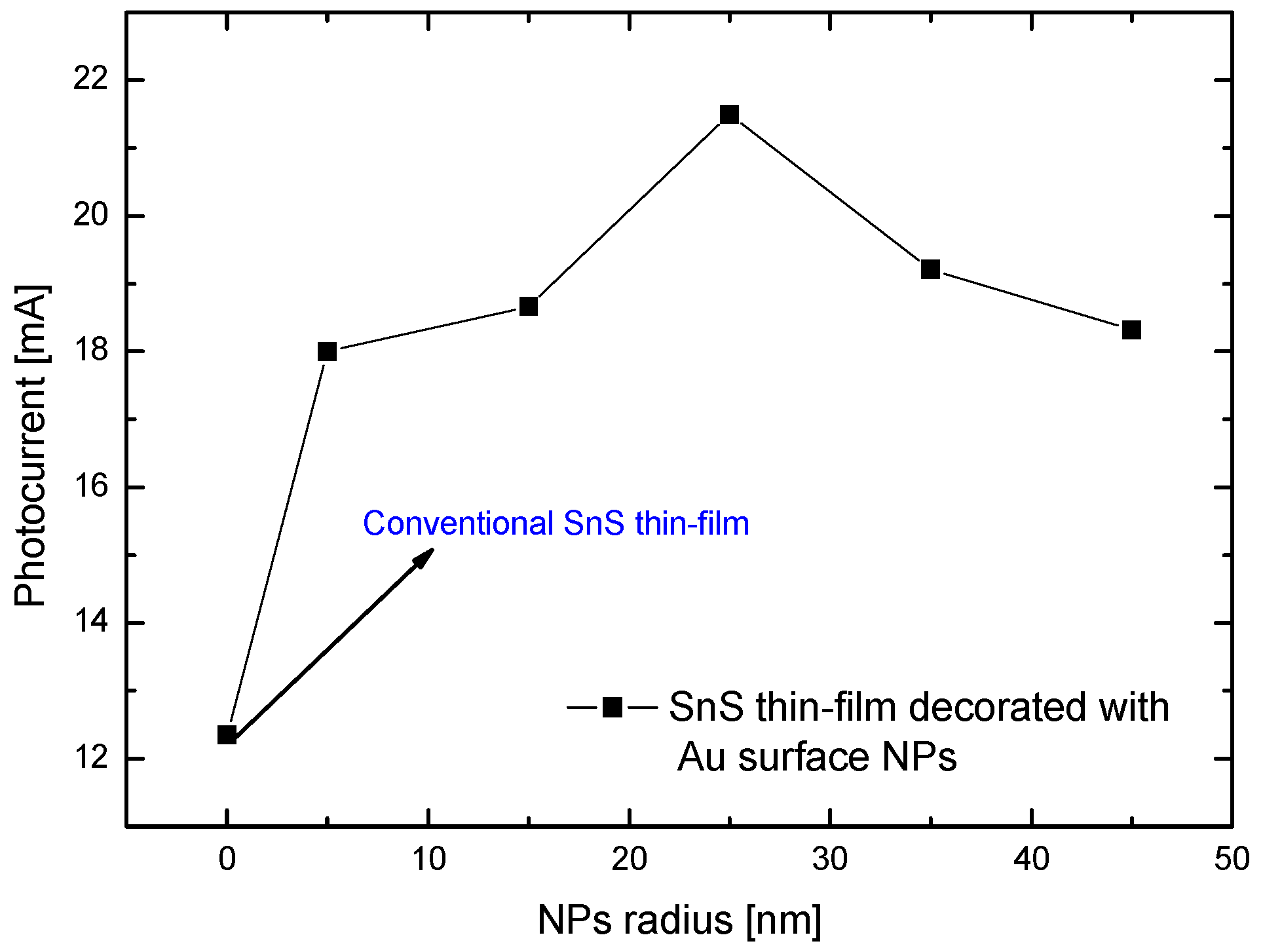Photoresponsivity Enhancement of SnS-Based Devices Using Machine Learning and SCAPS Simulations †
Abstract
:1. Introduction
2. Device Structure and Modeling Frameworks
2.1. Device Structure
2.2. Modeling Frameworks
3. Results and Discussion
4. Conclusions
Author Contributions
Funding
Institutional Review Board Statement
Informed Consent Statement
Data Availability Statement
Conflicts of Interest
References
- Kawamura, F.; Song, Y.; Murata, H.; Tampo, H.; Nagai, T.; Koida, T.; Imura, M.; Yamada, N. Tunability of the bandgap of SnS by variation of the cell volume by alloying with A.E. elements. Sci. Rep. 2022, 12, 7434. [Google Scholar] [CrossRef] [PubMed]
- Zhang, H.; Li, H.; Yu, H.; Wang, F.; Song, X.; Xu, Z.; Wei, D.; Zhang, J.; Dai, Z.; Ren, Y.; et al. High responsivity and broadband photodetector based on SnS2/Ag2S heterojunction. Mater. Lett. 2023, 330, 133037. [Google Scholar] [CrossRef]
- Dong, W.; Lu, C.; Luo, M.; Liu, Y.; Han, T.; Ge, Y.; Xue, X.; Zhou, Y.; Xu, X. Enhanced UV–Vis photodetector performance by optimizing interfacial charge transportation in the heterostructure by SnS and SnSe2. J. Colloid Interface Sci. 2022, 621, 374–384. [Google Scholar] [CrossRef] [PubMed]
- Ye, Z.; Yu, H.; Wei, J.; Xie, Y. Direct observation of kinetic characteristic on SnS-based self-powered photodetection. J. Lumin 2023, 253, 119473. [Google Scholar] [CrossRef]
- Kacha, K.; Djeffal, F.; Ferhati, H.; Foughali, L.; Bendjerad, A.; Benhaya, A.; Saidi, A. Efficiency improvement of CIGS solar cells using RF sputtered TCO/Ag/TCO thin-film as prospective buffer layer. Ceram. Int. 2022, 48, 20194–20200. [Google Scholar] [CrossRef]
- Trukhanov, S.V.; Bodnar, I.V.; Zhafar, M.A. Magnetic and electrical properties of (FeIn2S4)1−x(CuIn5S8)x solid solutions. J. Magn. Magn. Mater. 2015, 379, 22–27. [Google Scholar] [CrossRef]
- Bodnar, I.V.; Jaafar, M.A.; Pauliukavets, S.A.; Trukhanov, S.V.; Victorov, I.A. Growth, optical, magnetic and electrical properties of CuFe2.33In9.67S17.33 single crystal. Mater. Res. Express 2015, 2, 085901. [Google Scholar] [CrossRef]
- Zdorovets, M.V.; Kozlovskiy, A.L.; Shlimas, D.I.; Borgekov, D.B. Phase transformations in FeCo—Fe2CoO4/Co3O4-spinel nanostructures as a result of thermal annealing and their practical application. J. Mater. Sci. Mater. Electron. 2021, 32, 16694–16705. [Google Scholar] [CrossRef]
- Migas, D.B.; Turchenko, V.A.; Rutkauskas, A.V.; Trukhanov, S.V.; Zubar, T.I.; Tishkevich, D.I.; Trukhanov, A.V.; Skorodumova, N.V. Temperature induced structural and polarization features in BaFe12O19. J. Mater. Chem. C 2023, 11, 12406–12414. [Google Scholar] [CrossRef]
- Troyanchuk, I.O.; Trukhanov, S.V.; Szymczak, H.; Baerner, K. Effect of oxygen content on the magnetic and transport properties of Pr0.5Ba0.5MnO3-γ. J. Phys. Condens. Matter. 2000, 12, L155–L158. [Google Scholar] [CrossRef]
- Kozlovskiy, A.; Egizbek, K.; Zdorovets, M.V.; Ibragimova, M.; Shumskaya, A.; Rogachev, A.A.; Ignatovich, Z.V.; Kadyrzhanov, K. Evaluation of the efficiency of detection and capture of manganese in aqueous solutions of FeCeOx nanocomposites doped with Nb2O5. Sensors 2020, 20, 4851. [Google Scholar] [CrossRef] [PubMed]
- Berghout, T.; Mouss, M.-D.; Mouss, L.-H.; Benbouzid, M. ProgNet: A Transferable Deep Network for Aircraft Engine Damage Propagation Prognosis under Real Flight Conditions. Aerospace 2022, 10, 10. [Google Scholar] [CrossRef]



| Hyperparameters | Assigned Values |
|---|---|
| Maximum number of epochs | 300 |
| Mini batch size | 30 |
| Neurons | 20 |
| Learning algorithm | Adam optimizer |
| Initial learning rate | 0.01 |
| Gradient threshold | 1 |
| L2 regularization | 0.0001 |
| LSTM | ||||
|---|---|---|---|---|
| Cross-validation Folds | RMSE | MSE | MAE | R2 |
| 1 | 9.49 × 10−4 | 9.00 × 10−7 | 6.85 × 10−4 | 0.72 |
| 2 | 1.03 × 10−3 | 1.07 × 10−6 | 7.10 × 10−4 | 0.75 |
| 3 | 1.25 × 10−3 | 1.56 × 10−6 | 9.16 × 10−4 | 0.65 |
| Average | 1.07 × 10−3 | 1.18 × 10−6 | 7.7 × 10−4 | 0.71 |
| Standard deviation | 4.91 × 10−4 | 0.051 | ||
| MLP | ||||
| Cross-validation folds | RMSE | MSE | MAE | R2 |
| 1 | 2.09 × 10−3 | 4.40 × 10−6 | 1.63 × 10−3 | −0.36 |
| 2 | 1.65 × 10−3 | 2.74 × 10−6 | 1.31 × 10−3 | 0.382 |
| 3 | 1.37 × 10−3 | 1.89 × 10−6 | 1.12 × 10−3 | 0.58 |
| Average | 1.71 × 10−3 | 3.01 × 10−6 | 1.35 × 10−3 | 0.20 |
| Standard deviation | 8.11 × 10−4 | 0.5003 | ||
Disclaimer/Publisher’s Note: The statements, opinions and data contained in all publications are solely those of the individual author(s) and contributor(s) and not of MDPI and/or the editor(s). MDPI and/or the editor(s) disclaim responsibility for any injury to people or property resulting from any ideas, methods, instructions or products referred to in the content. |
© 2023 by the authors. Licensee MDPI, Basel, Switzerland. This article is an open access article distributed under the terms and conditions of the Creative Commons Attribution (CC BY) license (https://creativecommons.org/licenses/by/4.0/).
Share and Cite
Maoucha, A.; Djeffal, F.; Berghout, T.; Ferhati, H. Photoresponsivity Enhancement of SnS-Based Devices Using Machine Learning and SCAPS Simulations. Eng. Proc. 2023, 58, 128. https://doi.org/10.3390/ecsa-10-16014
Maoucha A, Djeffal F, Berghout T, Ferhati H. Photoresponsivity Enhancement of SnS-Based Devices Using Machine Learning and SCAPS Simulations. Engineering Proceedings. 2023; 58(1):128. https://doi.org/10.3390/ecsa-10-16014
Chicago/Turabian StyleMaoucha, Abdelhak, Faycal Djeffal, Tarek Berghout, and Hichem Ferhati. 2023. "Photoresponsivity Enhancement of SnS-Based Devices Using Machine Learning and SCAPS Simulations" Engineering Proceedings 58, no. 1: 128. https://doi.org/10.3390/ecsa-10-16014







